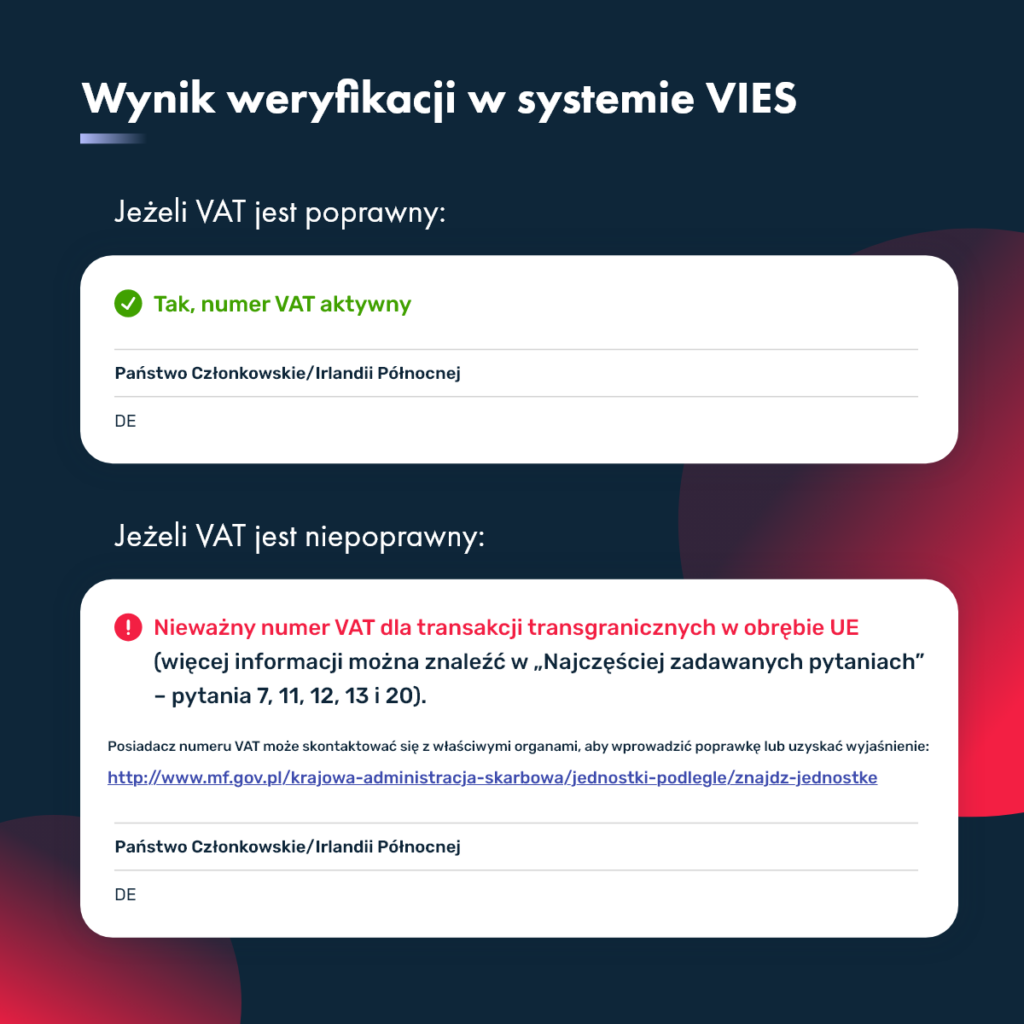What is a European TIN and what does it look like?
The difference between a European tax identification number and a regular TIN is small – to the standard number you need to add the code of the country in which the business is registered. In Poland, this will be the prefix “PL,” followed by a string of 10 digits, constituting the NIP.
Important!
The TIN does not look the same in every European Union member country. In addition to the prefix, the characteristics of the string and their number also change. If you are not sure whether the tax identification number provided by the contractor is correct, you can verify it using the VIES system.
How to verify the VAT number for cross-border transactions within the EU?
To do this, visit the VIES website, from the drop-down list select the prefix appropriate for the member state where your contractor operates, and then enter the VAT number you received from him (important: already without the prefix). After clicking the “Verify” button, you will get the search result:

Although in most EU member states the VAT number consists of a prefix and a sequence of digits alone (this is the case in Croatia, Denmark or Portugal, for example), there are a few exceptions to this rule:
- In Austria, the first character in the VAT number (after the prefix) is always the letter “U.”
- Cypriot companies will have a letter at the end of their VAT number,
- In France, the first or second character of a VAT number can be a letter (but never an “I” or “O”),
- in Spain, the letters can appear as the first or last character of the VAT number,
- Companies registered in the Netherlands use VAT numbers in which the third character from the end is always the letter “B.”
- in Ireland, the last character of the VAT number is a letter, and in addition, the second place of the number can have a letter, a number, or even a “+” or “*” sign.
Important!
If you write down the VAT number of a German counterparty yourself, remember that companies in the country of our western neighbors have two VAT numbers – one is for internal transactions and the other for cross-border transactions. Make sure you use the correct one. When in doubt, use the search engine.
What does a TIN number with an EU prefix mean?
There is a format for TINs that is of concern to businesses – it is VAT numbers preceded by the prefix EU. Such a number is assigned to companies outside the European Union that use the special procedure for accounting for VAT. In Art. 22f pt. 3 of the updof reads that a taxpayer may make one-time depreciation write-offs if the initial value of a given fixed asset is equal to or less than PLN 10,000.
Important!
If you receive an invoice from a seller who uses a VAT number with an EU prefix, you cannot treat the transaction as a VAT! Such a transaction should be accounted for as an import of goods or services from a contractor outside the European Union.
When do you need to have an EU TIN?
The law is clear: the obligation to have a European TIN applies to all entrepreneurs who intend to enter into transactions within:
- WNT (intra-Community acquisition of goods),
- WDT (intra-Community delivery of goods),
- Intra-Community supply of services (if the obligation to account for VAT belongs to the purchaser),
- Intra-Community acquisition of services (if the obligation to account for VAT belongs to the seller).
Is it necessary to have a European TIN if the taxpayer is exempt from VAT?
An EU TIN will also be needed for a VAT-exempt company, just like a VAT taxpayer. However, there is an exception to this rule.
Let’s assume that the taxpayer plans to carry out a transaction under intra-Community acquisition of goods, and the value of the taxpayer’s VAT will not exceed the amount of PLN 50,000 per year. In such a situation, and provided that this taxpayer enjoys a VAT exemption, he does not have to register for VAT-EU.
This provision can be found in Art. 97 par. 2 of the VAT Law.
How to obtain an EU TIN?
If you are already planning to work with foreign contractors at the stage of setting up your business, register for VAT-EU. To do this, fill out Part C.3 of the VAT-R form at the time of registration. This element of the form applies to intra-Community transactions. You can deliver the VAT-R to your tax office or send it online using the ePUAP system.
If you’re already in business, you’ll obtain a European TIN in exactly the same way – just download the VAT-R form, fill it out and submit it to the tax office responsible for your company – either traditionally or electronically.
The EU TIN should be issued within a few days, so that you will already be able to do business with foreign contractors within a short time after registration.
Important!
Remember that you need the European Tax Identification Number already at the time of entering into the first transaction with a foreign entity. So make sure you apply for an EU TIN even before you finalize the transaction.



